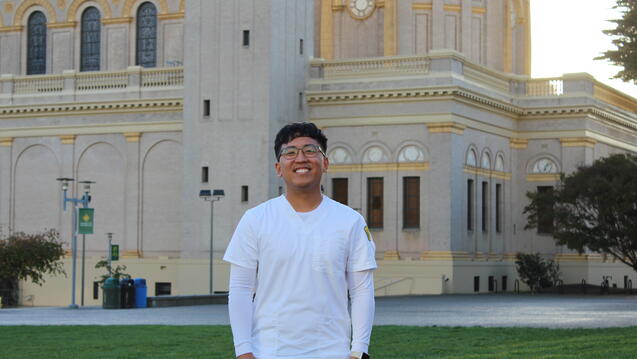Mission-Driven Research Making a Real Impact on Lives

Annette Regan is an Associate Professor in the Masters of Public Health Program, the Vice Chair of the Health Professions Department, and the Director of the Applied Epidemiology and Population Health Methods Concentration in Orange County in the School of Nursing and Health Professions.
She also serves the university as the Co-Director for the Center for Research, Artistic, and Scholarly Excellence. Her research program aims to promote healthy pregnancies and infants and ensure equitable access to life-saving vaccines. She uses “big data” to answer clinically and personally meaningful questions about vaccines.
In a conversation with Associate Professor Regan, she shares her experiences building a mission-driven research program and collaborating with health researchers across the globe.
How do you develop your research ideas?
100% of my work has been driven by an emerging question in the community. My goal as a researcher is to provide reliable information for people to make decisions – whether that be parents, pregnant people, or policymakers. This has included studies to help parents make a decision about a vaccine they are considering taking or how long they should wait to have another baby.
I want to do something meaningful that will allow us to either change the course or improve how we use vaccines.”
Some of my research has been in response to feeling frustrated about a health issue and wishing we had better data to answer an important question. A good example of this is my recent work on flu vaccine and miscarriage. In 2017, a study with a small number of people vaccinated in consecutive seasons suggested that the flu vaccine could increase the risk of miscarriage. After reading the article closely, I did not believe the data were sufficient to make this conclusion. I had serious issues with the sample size and how people were recruited into the study. Several other scientists agreed with me. Unfortunately, the news doesn't pay attention to the methodology or to the fact that epidemiologists had expressed concerns about how much we should rely on the results from this one study, and this particular study got a lot of media attention. In fact, this study got so much attention that subsequent studies have shown that this reduced the confidence of obstetricians in recommending or giving flu vaccines early in pregnancy.
In 2018, with frustration, I approached a researcher from Boston University, and we co-designed a much larger cohort study where we were able to follow people from before they were pregnant all the way through delivery. In 2023, we published our results in the Green Journal, which showed no link between the flu vaccine and miscarriage. We know flu vaccination is important in protecting both pregnant people and their young infants after birth, so we’re hoping that these results will be communicated widely to clinicians working directly with pregnant patients to increase their vaccine confidence.
In your experience, how do you maintain productivity as a researcher?
My secret to being highly productive is building a solid research community. There is a lot for us to learn, and we can learn more quickly and efficiently together. Research often means working in big, sometimes international, teams and juggling many different projects. Currently, I work with investigators across the US and 13 other countries, spanning Chile to Albania. My research “bestie” is in Ontario, Canada and we continually text each other to develop new ideas and troubleshoot data problems.
I often think of research as a companion planting exercise. Just like planting basil can help tomatoes grow better, bringing others into your research network can not only give you extra hands, but also gives you complementary skills and experiences as a research team. Within teams and projects you will have different roles; it's not always me leading the work, sometimes I'm doing a small piece or providing a perspective, and sometimes it is me leading the project. But we are always supporting each other and collaborating to make sure the research program is a success.
How do you develop a research team?
There are many ways to develop a research team; you might be invited to join a project, meet someone at a conference, or be introduced through a commissioned project. For example, my colleagues at the CDC have introduced me to other researchers at the Pan-American Health Organization (PAHO) and this has led to a number of other collaborative projects together. Your network naturally grows over time; you just have to be open to it.
How has USF impacted your research?
USF’s people and mission have opened up a different door in my research. I’m working across disciplines and with a social justice lens.”
Being faculty at USF has opened my research in two ways. First, I have been able to network and collaborate with people whom I wouldn’t normally have the opportunity to work with - including nurses, midwives, economists, and data scientists. I am always looking for researchers interested and willing to jointly find answers, co-plan a workshop around a topic, and invest their time in discussing ideas or solutions. I have been able to find new collaborators within my school and across the university, and this has really expanded the methodologies I’ve been able to use and my approaches to research questions. Second, our university has a clear focus on social justice and addressing social inequities. Unfortunately, we continue to see health inequities when it comes to maternal and child health and vaccine-preventable disease prevention. I find that at USF I have more encouragement to focus on these issues in my ongoing research, and I have the opportunity to collaborate with colleagues at my university who are addressing other aspects of health inequities.
How do you disseminate such important findings that impact people’s lives?
I think as scientists, we heavily rely on the mass media to share our findings with the public. While some may read medical journal articles, I wouldn’t say that journal articles reach a large section of the community. We always share the results directly with participants and use targeted social media to more broadly reach audiences who may be impacted by the research findings (i.e., pregnant people, parents of young children). As much as possible I try to connect my research with the community. For example, we have a grant right now where we are evaluating how teens and parents make the decision to vaccinate or not. We are focusing on COVID-19 vaccines right now, but we are hoping to look at other vaccines like HPV in the future. To ensure the results get out to parents, we partnered with the Center for Teen-Parent Communication at the Children's Hospital of Philadelphia who will develop a whole campaign and website push to share results from our study.
I am very proud that my research has been used to support the national and international vaccine policies.”
Any last words of wisdom for future researchers?
Grow your network. Start your companion planting and cross-pollination as soon as possible. Find your research “besties” and opportunities to connect and grow as a researcher. You can do this at your current institution, at meetings and conferences, or even via “cold calls.” And remember to have fun with it! Research can be such a rewarding opportunity, where you can make a real impact on lives while also getting a chance to work and play with very different people from around the world. It’s definitely worth it.


